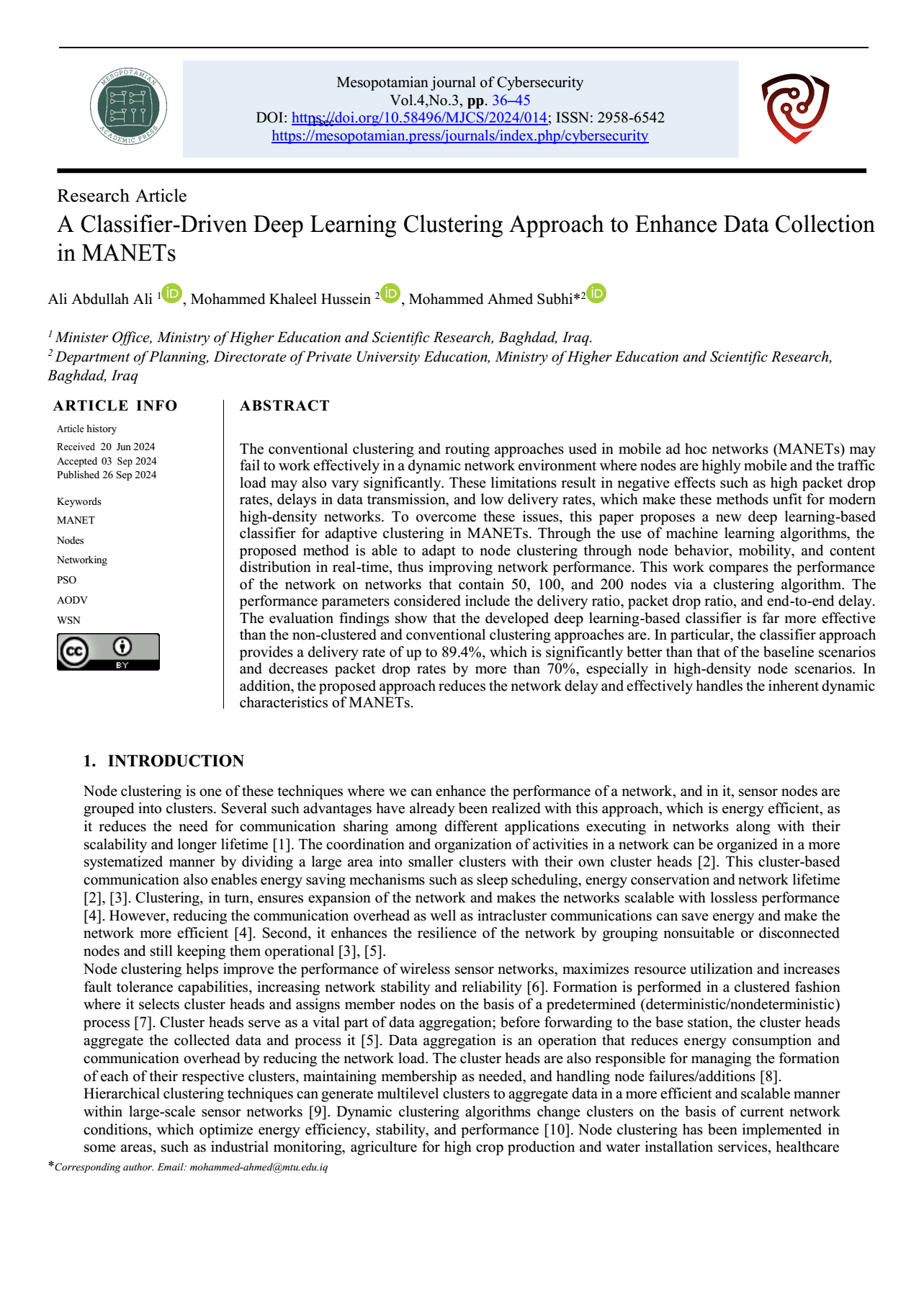A Classifier-Driven Deep Learning Clustering Approach to Enhance Data Collection in MANETs
Main Article Content
Abstract
The conventional clustering and routing approaches used in mobile ad hoc networks (MANETs) may fail to work effectively in a dynamic network environment where nodes are highly mobile and the traffic load may also vary significantly. These limitations result in negative effects such as high packet drop rates, delays in data transmission, and low delivery rates, which make these methods unfit for modern high-density networks. To overcome these issues, this paper proposes a new deep learning-based classifier for adaptive clustering in MANETs. Through the use of machine learning algorithms, the proposed method is able to adapt to node clustering through node behavior, mobility, and content distribution in real-time, thus improving network performance. This work compares the performance of the network on networks that contain 50, 100, and 200 nodes via a clustering algorithm. The performance parameters considered include the delivery ratio, packet drop ratio, and end-to-end delay. The evaluation findings show that the developed deep learning-based classifier is far more effective than the non-clustered and conventional clustering approaches are. In particular, the classifier approach provides a delivery rate of up to 89.4%, which is significantly better than that of the baseline scenarios and decreases packet drop rates by more than 70%, especially in high-density node scenarios. In addition, the proposed approach reduces the network delay and effectively handles the inherent dynamic characteristics of MANETs.
Article Details
Issue
Section

This work is licensed under a Creative Commons Attribution 4.0 International License.
How to Cite
References
A. A. Abbasi and M. Younis, “A survey on clustering algorithms for wireless sensor networks,” Comput Commun, vol. 30, no. 14–15, pp. 2826–2841, Oct. 2007, doi: 10.1016/j.comcom.2007.05.024.
W. R. Heinzelman, A. Chandrakasan, and H. Balakrishnan, “Energy-Efficient Communication Protocol for Wireless Microsensor Networks,” 2000.
W. R. Heinzelman, J. Kulik, and H. Balakrishnan, “Adaptive Protocols for Information Dissemination in Wireless Sensor Networks,” 1999.
O. Younis and S. Fahmy, “HEED: A Hybrid, Energy-Efficient, Distributed Clustering Approach for Ad-hoc Sensor Networks.”
O. Boyinbode, H. Le, A. Mbogho, M. Takizawa, and R. Poliah, “A survey on clustering algorithms for wireless sensor networks,” in Proceedings - 13th International Conference on Network-Based Information Systems, NBiS 2010, 2010, pp. 358–364. doi: 10.1109/NBiS.2010.59.
M. K. Khan et al., “Hierarchical Routing Protocols for Wireless Sensor Networks: Functional and Performance Analysis,” Journal of Sensors, vol. 2021. Hindawi Limited, 2021. doi: 10.1155/2021/7459368.
T. Spyropoulos, K. Psounis, and C. S. Raghavendra, “Efficient routing in intermittently connected mobile networks: The multiple-copy case,” IEEE/ACM Transactions on Networking, vol. 16, no. 1, pp. 77–90, Feb. 2008, doi: 10.1109/TNET.2007.897964.
A. Manjeshwar and D. P. Agrawal, “TEEN: A routing protocol for enhanced efficiency in wireless sensor networks,” in Proceedings - 15th International Parallel and Distributed Processing Symposium, IPDPS 2001, Institute of Electrical and Electronics Engineers Inc., 2001, pp. 2009–2015. doi: 10.1109/IPDPS.2001.925197.
A. Shahraki, A. Taherkordi, Ø. Haugen, and F. Eliassen, “Clustering objectives in wireless sensor networks: A survey and research direction analysis,” Computer Networks, vol. 180, Oct. 2020, doi: 10.1016/j.comnet.2020.107376.
N. Dimokas, D. Katsaros, and Y. Manolopoulos, “Energy-efficient distributed clustering in wireless sensor networks,” J Parallel Distrib Comput, vol. 70, no. 4, pp. 371–383, Apr. 2010, doi: 10.1016/j.jpdc.2009.08.007.
Kaya E, Gorkemli B, Akay B, Karaboga D. A review on the studies employing artificial bee colony algorithm to solve combinatorial optimization problems. Engineering Applications of Artificial Intelligence. 2022 Oct 1;115:105311.
A. Radwan, N. H. Kamarudin, M. I. Solihin, and Y. Leong, “A Survey on Energy Efficient Clustering Algorithms for Wireless Sensor Networks.” [Online]. Available: www.solidstatetechnology.us
P. C. Srinivasa Rao and H. Banka, "Energy efficient clustering algorithms for wireless sensor networks: novel chemical reaction optimisation approach," Wireless Networks, vol. 23, no. 2, pp. 433–452, Feb. 2017, doi: 10.1007/s11276-015-1156-0.
H. Yang, H. Luo, F. Ye, S. Lu, and L. Zhang, “Security in Mobile Ad Hoc Networks: Challenges and Solutions,” IEEE Wireless Communications, vol. 11, no. 1. pp. 38–47, Feb. 2004. doi: 10.1109/MWC.2004.1269716.
D. Karaboga and B. Akay, “A comparative study of Artificial Bee Colony algorithm,” Appl Math Comput, vol. 214, no. 1, pp. 108–132, Aug. 2009, doi: 10.1016/j.amc.2009.03.090.
S. Ostapenko, A. P. Africano, and R. Meneses, “Cluster dynamics and firms’ strategies – an integrative framework,” EuroMed Journal of Business, 2022, doi: 10.1108/EMJB-01-2022-0014.
S. N. M. Raj, D. Bhattacharyya, D. Midhunchakkaravarthy, and T. Hoon Kim, "Multi-hop in Clustering with Mobility Protocol to Save the Energy Utilization in Wireless Sensor Networks," Wirel Pers Commun, vol. 117, no. 4, pp. 3381–3395, Apr. 2021, doi: 10.1007/s11277-021-08078-y.
M. A. Khan et al., “A Survey on the Noncooperative Environment in Smart Nodes-Based Ad Hoc Networks: Motivations and Solutions,” Security and Communication Networks, vol. 2021, 2021, doi: 10.1155/2021/9921826.
N. Vlajic and D. Xia, “Wireless Sensor Networks: To Cluster or Not To Cluster?,” 2006.
X. Liu and J. Shi, “Clustering routing algorithms in wireless sensor networks: An overview,” KSII Transactions on Internet and Information Systems, vol. 6, no. 7, pp. 1735–1755, Jul. 2012, doi: 10.3837/tiis.2012.07.001.
Mythili D, “Coswarm-LEACH-Optimal Throughput and Energy Efficiency Routing Protocol for Wireless Sensor Networks.” [Online]. Available: https://museonaturalistico.it
S. He, Q. Li, M. Khishe, A. Salih Mohammed, H. Mohammadi, and M. Mohammadi, "The optimisation of nodes clustering and multi-hop routing protocol using hierarchical chimp optimisation for sustainable energy efficient underwater wireless sensor networks," Wireless Networks, vol. 30, no. 1, pp. 233–252, Jan. 2024, doi: 10.1007/s11276-023-03464-9.




